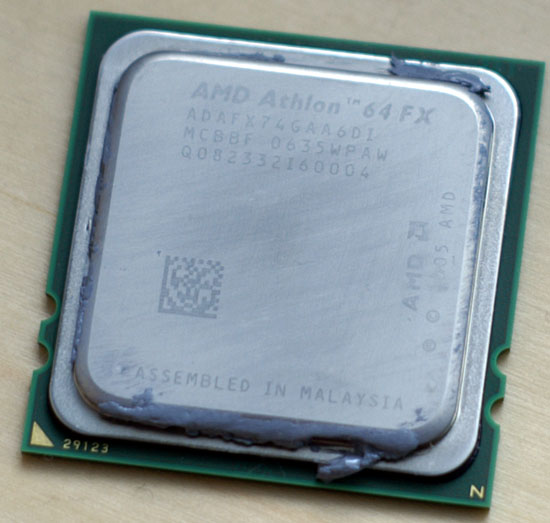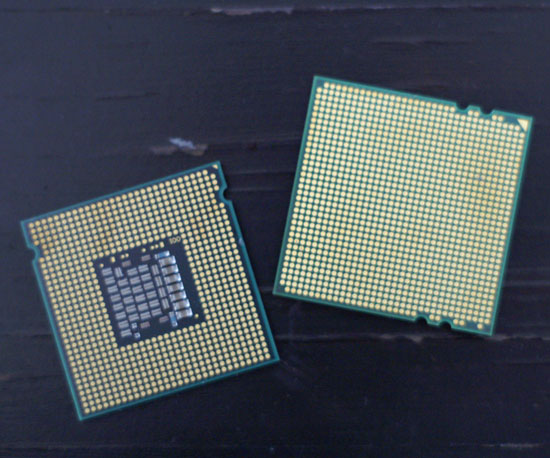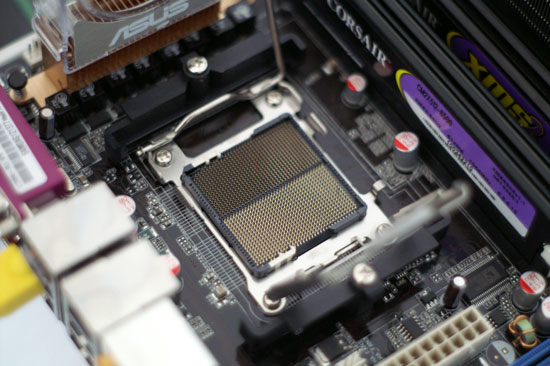AMD's Quad FX: Technically Quad Core
by Anand Lal Shimpi on November 30, 2006 1:16 PM EST- Posted in
- CPUs
The Processors
To complete the brand new Quad FX platform AMD is introducing three new processors today: the Athlon 64 FX-74, FX-72 and FX-70, running at 3.0GHz, 2.8GHz and 2.6GHz respectively. Each physical processor features two cores and a 1MB L2 cache per core, much like previous dual core FX processors, but what sets these CPUs apart from previous FX chips is that they are sold in bundles of two. So when you buy an Athlon 64 FX-74, you are actually buying two dual-core CPUs in a single box. It's not the most elegant way of getting four cores, but it gets the job done and AMD manages to do so at a competitive price. Note that these CPUs are effectively Opterons but with the memory controller configured to support un-buffered DDR2.

The Chip

Core 2 Duo (left) vs. Athlon 64 FX-74 (right), AMD's first LGA desktop CPU
AMD's pricing structure, including the new Quad FX processors, is as follows, with Intel's upper echelon CPUs thrown in for comparison:
| CPU | Clock Speed | L2 Cache | Price |
| AMD Athlon 64 FX-74* | 3.0GHz | 1MB per core | $999 |
| AMD Athlon 64 FX-72* | 2.8GHz | 1MB per core | $799 |
| AMD Athlon 64 FX-70* | 2.6GHz | 1MB per core | $599 |
| AMD Athlon 64 FX-62 | 2.8GHz | 1MB per core | $713 |
| AMD Athlon 64 X2 5200+ | 2.6GHz | 1MB per core | $403 |
| Intel Core 2 Extreme QX6700 | 2.66GHz | 4MB per 2 cores | $999 |
| Intel Core 2 Quad Q6600** | 2.40GHz | 4MB per 2 cores | $851 |
| Intel Core 2 Extreme X6800 | 2.93GHz | 4MB | $999 |
| Intel Core 2 Duo E6700 | 2.66GHz | 4MB | $530 |
* Note: These processors come in pairs of two, pricing is for both CPUs
** Note: The Core 2 Quad Q6600 is an unreleased CPU and will be introduced in January 2007.
So for $999 you can either get two dual core 3.0GHz AMD processors, or a single quad core 2.66GHz Core 2 Extreme QX6700. Later we'll figure out which is indeed faster but it seems that AMD's pricing is at least competitive.
The Roadmap
When we first heard that Quad FX wasn't going to be Socket-AM2, we couldn't help but feel that AMD was introducing yet another Socket-940 into the mix. Is there really a future for Quad FX or is it nothing more than a stop-gap solution until native quad-core CPUs arrive?

The Socket
AMD has already committed to supporting two quad-core CPUs in current Quad FX platforms, so there's at least an upgrade path well into 2007, but what happens afterwards?
AMD's most recent roadmaps show continued support for Quad FX throughout 2007; in fact, the highest clock speed AMD CPUs will always be Socket-1207 parts (3.0GHz today and then 3.2GHz by Q2 '07). It looks like AMD is transitioning the Athlon 64 FX line to be exclusively for the Quad FX platform, leaving all other chips for AM2.










88 Comments
View All Comments
Nighteye2 - Thursday, November 30, 2006 - link
I'm interested in that as well. NUMA will be an important part of 4x4 performance - so why isn't NUMA used in the benchmark, or at least mentioned. NUMA is the advantage of having 2 sockets - having NUMA disabled in this benchmark by using an OS that does not support it unfairly cripples the 4x4 performance.Viditor - Thursday, November 30, 2006 - link
Agreed...I think that one of the reasons that AMD delayed release of this so long is that they wanted to show it on Vista instead of WinXP. It seems to me that there would be a substantial difference between the 2...
Viditor - Thursday, November 30, 2006 - link
As a follow up on just how important NUMA is for 4x4, check out http://babelfish.altavista.com/babelfish/trurl_pag...">this review which actually compares the 2...There is a DRASTIC difference between performance on XP and Vista!
Accord99 - Friday, December 1, 2006 - link
Most of the difference is running in 64-bit mode. The extra bandwidth didn't help the FX-74 in the megatasking bench. They didn't do any game benchmarks but based on past reviews of NUMA, the FX-74 will probably keep on losing to the FX-62 in games.Viditor - Friday, December 1, 2006 - link
I'm not sure I agree...there's a 22.5% increase in performance there, and I haven't seen anything like that on the 64 bit version of 3DS Max before...
Not to mention that Vista isn't known as a real speed demon (quite the opposite) for these apps...
What the 64bit version does is allow for larger scene use and stability, not so much faster rendering.
photoguy99 - Friday, December 1, 2006 - link
Sorry totally wrong -
64-bit can make a big difference in performance depending on the app. Remember you can process 64 bits of data in a typical instruction instead of 32, so theoretically twice as much pixel data at a time for rendering.
Some apps may not show the full benefit it depends on how they are coded and compiled, but it's definitely a real potential for speedup.
Bottom line is 64-bit could easily account for a bigger performance increase than NUMA.
Kiijibari - Friday, December 1, 2006 - link
You see that he refers already to 3DS MAX .. I have not investigated this, but if he refers to it, then I trust him on that one ...
Futhermore I miss synthetical Sandra Mem bandwidth benches .. these should easily show what is going on there ...
Anyways a 4x4 review without mentioning the XP - NUMA problem is just not worth reading it ... Sorry Anand ...
cheers
Kiijibari
Anand Lal Shimpi - Friday, December 1, 2006 - link
The performance deficit seen when running latency sensitive single and dual threaded applications exists even in a NUMA-aware OS (I've confirmed this under Vista). I'm still running tests under Vista but as far as I see, running in a NUMA-aware OS doesn't seem to change the performance picture at all.Take care,
Anand
Kiijibari - Saturday, December 2, 2006 - link
Hi Anand,first of all, thanks for your reply.
Then, if there is really no performance difference, then I would double check the BIOS, if you have really disabled node interleave.
Furthermore there seems to be a BIOS bug, with the SRAT ACPI tables, which are necessary for NUMA. It would be nice, if you can dig up some more information about that topic.
Clearly, that would be not your fault, but AMD's.
cheers
Kiijibari
Anand Lal Shimpi - Saturday, December 2, 2006 - link
From what I can tell the Node Interleave option in the BIOS is doing something. Disabling it (enabling NUMA) results in lower latencies than leaving it enabled, but still not as slow as running with a single socket.CPU-Z offers the following latencies for the three configurations:
2S, NUMA On: 168 cycles
2S, NUMA Off: 205 cycles
1S: 131 cycles
From my discussions with AMD last week, this behavior is expected. I will do some more digging to see if there's anything else I'm missing though.
Take care,
Anand